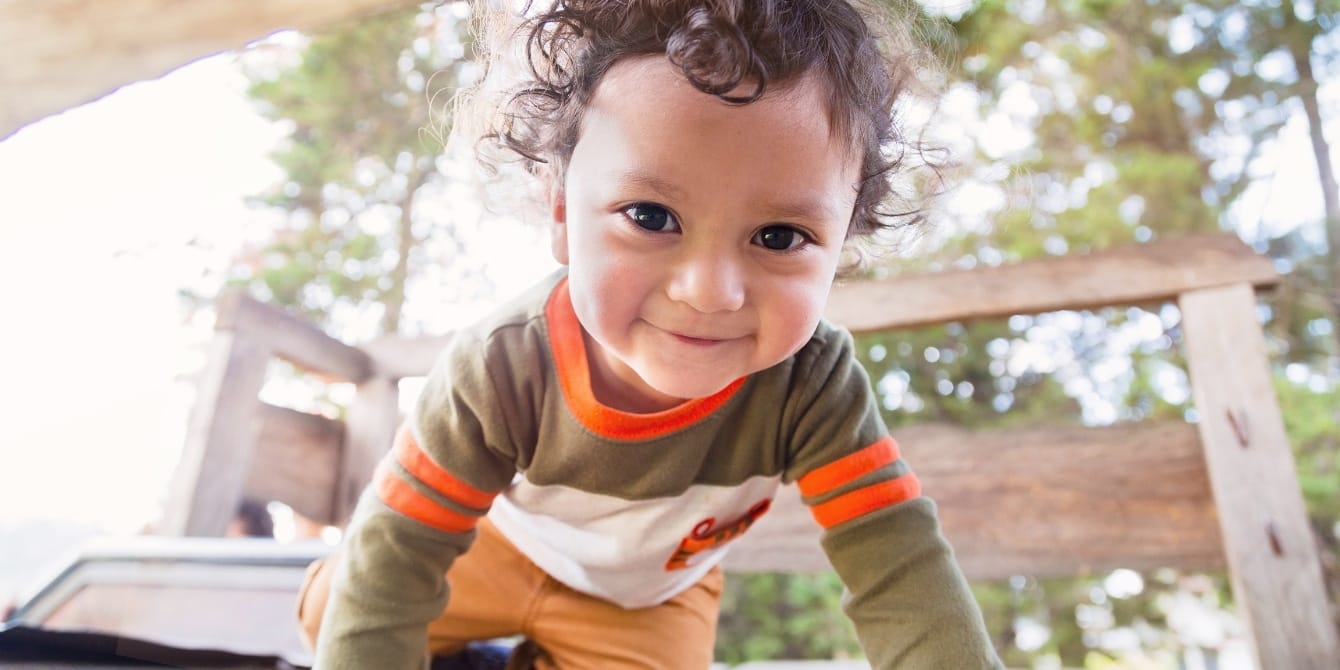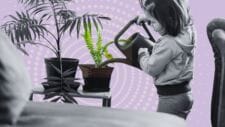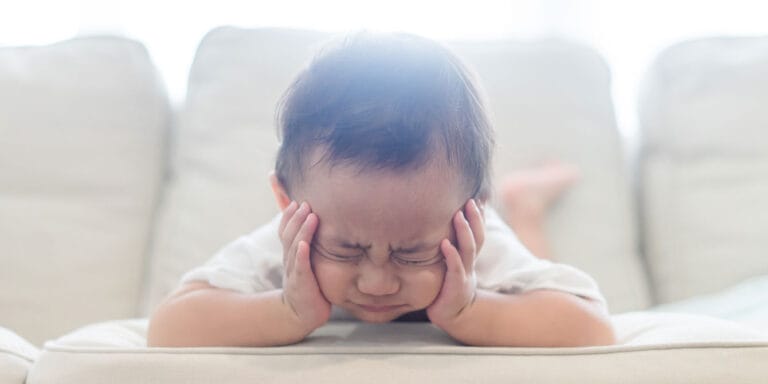2-year-old health & growth guide

Fernanda_Reyes/Shutterstock
Your curious, confident toddler is coming into their own.
We independently select and share the products we love—and may receive a commission if you choose to buy.
Table of Contents
In a word, your 2-year-old is *blossoming*. It might feel bittersweet to celebrate their 2nd birthday (already!), when they were just a tiny infant not so many moons ago. But now, your curious, confident toddler is coming into their own. From adding even more words to their vocabulary to engaging in more imaginative play and, of course, taking steps to test the limits of their independence, it’s a joy and a privilege to bear witness to their daily evolution. What a wild ride. Here’s what else you need to know about your 2-year-old’s health and growth this month.
Related: 2-year-old milestones
2-year-old nutrition
Exciting news: You can probably count on your 2-year-old to be able to feed themselves now, which means family mealtimes get even more fun. Your tot gets to feel like part of the crew, sitting at the table, chatting with the grownups. Cute! Keep encouraging that self-sufficiency by providing them with their own spoon, small fork, sippy cup and napkin for meals.
Your kiddo should generally be eating 3 meals per day with 2 or more snacks in between. As a guideline, for kids between the ages of 1 and 3, a serving size should be approximately one-quarter of an adult’s, AAP notes.
The AAP recommends the following feeding amounts for 2-year-olds:
- 1 ounce of meat, or 2 to 3 tablespoons of beans
- 1 to 2 tablespoons of vegetables
- 1 to 2 tablespoons of fruit
- 1/4 slice of bread
While solid food should be the primary source of your child’s nutrients and calories during this stage, if you choose to continue breastfeeding until beyond age 2, we have some helpful tips to support extended breastfeeding so that it remains a positive experience for both you and your little one. If that’s not in the cards for you? Cow’s milk can be a beneficial option as it provides valuable protein, vitamins, and minerals.
How to reach your extended breastfeeding goals
- Recognize your toddler has different needs: Feeding just 1 to 3 times per day may be all they need
- Keep up with one evening or nighttime feeding: Lactation hormones surge in the nighttime hours
- Communicate your needs and reach out for help: Ask for help coordinating pumping breaks and distraction-free time with your toddler
- Ignore the stigma: The health benefits for both you and your child are proven; and you don’t need anyone else’s approval to keep breastfeeding
Dealing with picky eating and food strikes
Though it might look different for each kid, picky eating is a very common challenge at this stage. That’s because the primary reason usually stems from the same place (unless it’s related to a feeding issue)—a need for independence. Your tot may start flat-out refusing foods they once liked, or only eat the same foods again and again—both of which can be frustrating for a parent.
But begging your child to “just try one bite” may be doing more harm than good. Instead, practice taking the pressure off. Recent research shows that letting your kid play with their food—with zero intention to actually eat it—can help them safely explore new tastes and textures in an anxiety-free environment. Kids learn through play, and bringing that concept to mealtime can be a game-changer for many kids, but especially for kids with sensory challenges or certain food or texture aversions.
Fill your child’s plate with a few foods they recognize and already enjoy, plus the addition of just one or two new foods to explore. Then, encourage them to get their hands dirty: Can they stack it, roll it, squish it? Letting kids touch and handle what’s on their plate with no expectation to actually taste it can depressurize the situation for all involved. And if they do end up tasting some? An added bonus!
Related: Actually, please *do* let your kids play with their food
2-year-old weight
For babies up to 2 years of age, the Centers for Disease Control and Prevention (CDC) recommend using the World Health Organization (WHO) weight and length charts.
The WHO growth charts for babies 0 to 2 years are based on what is standard for a predominantly breastfed infant. According to the organization, the WHO charts reflect growth patterns among children who were predominantly breastfed for at least 4 months and were still breastfeeding at 12 months. The American Academy of Pediatrics (AAP) recommends continuing to breastfeed for at least two years, as long as it benefits both mother and baby.
How much does the average 2-year-old weigh?
You have a growing 2-year-old! You likely won’t have to change out their clothing sizes every three months, but you might want to consider sizing up the next time you shop so that your little weed has room to grow.
According to the WHO and CDC:
- A 2-year-old boy in the 50th percentile weighs 26 pounds, 12 ounces (12.2 kilograms)
- A 2-year-old girl in the 50th percentile weighs 25 pounds, 5 ounces (11.5 kilograms)
What factors contribute to a 2-year-old’s weight?
Your toddler’s weight may be related to several different factors, including how much they’re eating, their assigned sex and their activity levels.
Assigned sex at birth: Boys tend to weigh slightly more than girls.
Daily food intake: The amount your child eats at each meal may factor into their weight.
Activity levels: From climbing to running, physical activity helps build strong muscles and bones—which means your kiddo’s activity levels may factor into their overall weight.
2-year-old height
Some estimates suggest that by doubling your 2-year-old’s current height, you’ll get a glimpse of how tall they’ll be as an adult. It’s just a prediction, but a fun one.
How tall is the average 2-year-old?
According to the WHO and CDC:
- A 2-year-old boy in the 50th percentile is 34 ½ inches tall (87.8 cm)
- A 2-year-old girl in the 50th percentile is 34 inches tall (86.4 cm)
What factors contribute to a 2-year-old’s height?
Your child’s genetics, nutrition, activity levels, sleep quantity and overall health all play a role in their height. But for a real clue at their future height, know that it may depend on how tall their parents are. Tall kids tend to have tall parents.
Growth charts and percentiles
Your child’s pediatrician has been plotting your little one’s weight, length and head circumference for two years now—which means you should have a good picture of their growth over time. It’s that overall growth curve that the doctor will examine, checking to make sure they’re on a steady trajectory.
Just trust that all babies grow at different rates, and rest assured that your child is healthy whether they fall in the 5th or 95th percentile, AAP says. Percentiles just provide an example of how a baby’s growth may be compared to that of other babies who are the same age and sex, too.
Once you get your child’s updated height and weight percentiles, here’s what those numbers signify: If your child’s weight is in the 45th percentile, that means that 55% of babies of the same age and sex weigh more, and 45% weigh less. The pediatrician will keep tracking their weight, height and head circumference for another year, but after age 3, they’ll just track height, weight and body mass index (BMI).


When should I worry about my baby’s growth?
If your child’s pediatrician is concerned about your 2-year-old’s growth, they’ll surely let you know. But it’s key to recognize that growth metrics are just one factor in the overall picture of a child’s health. Their doctor will also look to see if they’re meeting or approaching their developmental milestones, what their feeding and sleeping habits are like and how their social skills are progressing. If you’re concerned about something, bring it up with the pediatrician at your next appointment.
2-year-old baby sleep
Though they might insist otherwise, your 2-year-old still needs one nap during the day and at least 10 hours of consecutive sleep at night, for a combined total of 11 to 14 hours, says the American Academy of Sleep Medicine.
What sleep looks like at 2 years:
- Your child may be taking 1 nap per day
- Your child may no longer be waking at night
- Your child may be awake for 4 to 5 hours at a time
While there’s no specific age for when to transition your toddler to a toddler bed, AAP states that the best time to make the switch is once your child has attempted or learned how to climb out of their crib. That may be anytime between 18 months and 3 years. Though it can be bittersweet (for both of you) to say goodbye to their crib, it could become a safety issue: a fall while climbing out could be hazardous.
To ease the transition to a big-kid bed, consider starting with just their crib mattress on the floor, try a Montessori floor bed or pick out a toddler bed that your little one is excited about. Getting your child acclimated to their new sleeping arrangement could take about a week. To set them up for success, try the following tips.
Tips to ease the transition to a toddler bed
- Act out the big switch before it happens with stuffed animals
- Start their bedtime routine a little earlier to leave time for extra snuggles
- Gently but firmly (and repeatedly) guide them back to bed when they inevitably start exploring their newfound freedom
Related: Time for a toddler bed? How to ease the transition
Diapering a 2-year-old
Though diapers are likely still in your future for some time to come, this age may be a good time to start thinking about potty training if you haven’t yet. There are a few key signs to know if your child is ready to start potty training.
How to tell if your child is ready to start potty training
- They stay dry during daytime naps
- They can tell or announce when they’ve got a wet or dirty diaper
- They seem interested in using the toilet
- They can follow simple instructions
Some children may be ready now to start working on this new skill, but for others, it’ll be much later—closer to 3—and that’s all normal. You can start in a low-pressure way by setting out a toddler toilet in your bathroom, starting to talk about it and letting them get used to the idea of sitting on it.
The Montessori approach to toilet learning also encourages starting to have your child stand up for diaper changes and having the child push down and pull up their pants by themselves. These small steps can make for an easier transition down the line, and fosters more independence.
Caring for a 2-year-old
Here’s what to know about vaccines, baths, safety and care for your growing toddler.
Vaccines for 2-year-olds
The CDC has recommended that flu and Covid vaccines be an annual part of the routine childhood vaccinations offered to kids. Based on seasonality and when they had their last booster, your child may be due for their next dose. The flu and Covid vaccines help prevent severe illness or hospitalization in your child should they contract the viruses. If you have questions or concerns, be sure to speak with your child’s healthcare provider.
Baths
How often should you bathe your 2-year-old? A few times a week is sufficient. Young children still have sensitive skin that can dry out with too much soap exposure, so aim to use a mild soap or opt for a plain, warm water bath if they’re not that filthy, and keep bathtime relatively short—just 10 minutes or so.
Related: 14 bath safety tips for babies and kids of all ages
Supporting their independence
So much of the toddler phase comes down to a push-pull of a need for independence. One key to avoiding those battles? Giving them options. “Which pajamas do you want to wear tonight?” “Would you like yogurt or waffles for breakfast?” Letting your little one have more of a say in what they do, wear and eat can empower them to identify their own likes and dislikes—without too much of a struggle.
Safety: Avoiding button batteries
It can happen in the span of mere minutes—one moment, your little one is playing with that fun new battery-operated toy, the next, the battery compartment is open and you can’t find that silver button battery anywhere. Cue the panic: When swallowed, button batteries or lithium coin batteries can cause severe chemical burns and tissue damage, even leading to death. But if a button battery is accidentally ingested, giving kids honey at regular intervals until they can receive emergency medical care may help reduce the risk of injury.
Spare button batteries or lithium coin batteries should be stored out of children’s reach, but because the batteries can be found in so many household objects, kids may inadvertently get into them.
Early treatment is of the utmost importance, as burns can happen fast. AAP notes that corrosion can start to occur in as few as two hours after ingestion. But one study found that giving kids honey every 10 to 15 minutes can coat the battery and help it slide through the esophagus into the stomach while also neutralizing the pH to prevent a chemical burn.
What to do if your child has ingested a button battery
Swallowing a button battery or a lithium coin battery is always a medical emergency. Take your child to the nearest emergency room immediately.
If you have honey at home, give 2 teaspoons of honey to your child if they’re over 12 months old. You can give up to 6 doses of honey about 10 minutes apart. Do not give your child anything else to eat or drink, including water. If your child vomits, do not offer another dose of honey.
Most importantly, do not delay transport to the hospital to pick up honey, AAP notes.
Related: This toddler swallowed a button battery—her mom says ingesting honey helped save her life
Toddler nightmares
Around age 2, your child may start having nightmares. It’s a bit unsettling to think about your little love battling those scary dreams on their own, but rest assured that night terrors or nightmares are another way your babe’s developing brain is processing emotions and information, and your kiddo will eventually grow out of them. Anecdotally, they may tend to happen more when your toddler is overtired (another reason to prioritize that nap schedule!).
A note from Motherly on self-care while caring for a 2-year-old
To put it lightly, it can be a lot to balance a toddler’s rollercoaster emotions day in, day out, especially if you’re running on an empty tank. Make sure that you’re getting time to yourself to recharge—which is super important for being able to show up for your little one as their safe person. But if you’re struggling more than usual lately, reach out to your primary care provider, who may be able to recommend a therapist or other mental health support. There are people out there who want to help.
A version of this story was originally published on May 27, 2023. It has been updated.










































